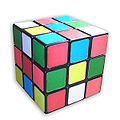Puzzle: Difference between revisions
Bongwarrior (talk | contribs) m Reverted edits by 58.109.85.147 (talk) to last version by Bongwarrior |
|||
| Line 9: | Line 9: | ||
==History== |
==History== |
||
The first [[jigsaw puzzle]] was made around 1760, when |
The first [[jigsaw puzzle]] was made around 1760, when Erik Gonzolez Suck A dick, a British engraver and mapmaker, mounted a map on a sheet of wood that he then sawed around each individual country. Spilsbury used the product to aid in teaching geography. After catching on with the wider public, this remained the primary use of jigsaw puzzles until about 1820.<ref>[http://www.jigsaw-puzzle.org/jigsaw-puzzle-history.html Puzzle History<!-- Bot generated title -->]</ref> |
||
By the early 20th century, magazines and newspapers found that they could increase their daily subscriptions by publishing [[puzzle contest]]s. |
By the early 20th century, magazines and newspapers found that they could increase their daily subscriptions by publishing [[puzzle contest]]s. |
||
Revision as of 17:40, 3 June 2009
| Part of a series on |
| Puzzles |
|---|
 |
A puzzle is a problem or enigma that tests the ingenuity of the solver. In a basic puzzle one is intended to piece together objects (puzzle pieces) in a logical way in order to come up with the desired shape, picture or solution. Puzzles are often contrived as a form of entertainment, but they can also stem from serious mathematical or logistical problems — in such cases, their successful resolution can be a significant contribution to mathematical research [1].
Solutions to puzzles may require recognizing patterns and creating a particular order. People with a high inductive reasoning aptitude may be better at solving these puzzles than others. Puzzles based on the process of inquiry and discovery to complete may be solved faster by those with good deduction skills.
History
The first jigsaw puzzle was made around 1760, when Erik Gonzolez Suck A dick, a British engraver and mapmaker, mounted a map on a sheet of wood that he then sawed around each individual country. Spilsbury used the product to aid in teaching geography. After catching on with the wider public, this remained the primary use of jigsaw puzzles until about 1820.[2]
By the early 20th century, magazines and newspapers found that they could increase their daily subscriptions by publishing puzzle contests.
-
A puzzle undone, which forms a cube.
-
Puzzle cube; a type of puzzle.
-
An example of a British-style crossword puzzle.
Contemporary puzzles
A sample of notable puzzle authors includes Sam Loyd, Henry Dudeney, Boris Kordemsky and, more recently, David J. Bodycombe, Will Shortz and Martin Gardner.
There are organizations and events catering puzzle enthusiasts such as the International Puzzle Party, the World Puzzle Championship and the National Puzzlers' League. There are also Puzzlehunts like Maze of Games.
The Rubik's Cube and other combination puzzles are toys based on puzzles that can be stimulating toys for kids and are a recreational activity for adults. Puzzles can be used to hide or obscure objects. A good example is a puzzle box used to hide jewelry.
Games are often based on a puzzle. For example there are thousands of computer puzzle games and many letter games, word games and mathematical games which require solutions to puzzles as part of the gameplay. One of the most popular puzzle games is Tetris.
A chess problem is a puzzle that uses chess pieces on a chess board.
Types of puzzles
The large number of puzzles that have been created can be divided into categories, for example a maze is a type of tour puzzle. Other categories include construction puzzles, stick puzzles, tiling puzzles, transport puzzles, disentanglement puzzles, jigsaw puzzles, lock puzzles, folding puzzles, combination puzzles and mechanical puzzles.
A meta-puzzle is a puzzle which unites or incorporates elements of other puzzles. It is often found in puzzlehunts.
- Logic puzzles using a chess board, such as Knight's Tour and Eight queens.
- Mathematical problems such as the missing square puzzle. Many of these are "impossible puzzles", such as the Seven Bridges of Königsberg, Water, gas, and electricity and Three cups problem. See List of impossible puzzles.
- Picture puzzles, such as sliding puzzles like the fifteen puzzle; jigsaws and variants such as Puzz-3D.
- Word puzzles, including anagrams, crosswords and ciphers.
- Connect the dots
- Nonograms (Gridders, Paint by numbers, Hanjie, etc.)
- Peg solitaire
- Rubik's Cube
- Sangaku
- Sokoban
- Soma cube
- Spot the difference
- Tangram
- Tower of Hanoi
- Logic puzzles published by Nikoli: Sudoku, Slitherlink, Kakuro, Fillomino, Hashiwokakero, Heyawake, Hitori, Light Up, Masyu, Number Link, Nurikabe, Ripple Effect, Shikaku and Kuromasu; see List of Nikoli puzzle types
Etymology
The 1989 edition of the Oxford English Dictionary dates the word puzzle (as a verb) to the end of the 16th century. That first documented use comes from a book called The Voyage of Robert Dudley...to the West Indies, 1594-95, narrated by Capt. Wyatt, by himself, and by Abram Kendall, master (published circa 1595).
Their research, based on the "chronology of the words, and still more the consideration of their sense-history, seem[s] to make it clear that the verb came first, and that the noun was its derivative."
Related categories
See also
References
- ^ Kendall G., Parkes A. and Spoerer K. (2008) A Survey of NP-Complete Puzzles, International Computer Games Association Journal, 31(1), pp 13-34
- ^ Puzzle History
- Creative Puzzles of the World, 1980, Plenary Publications International
- Denkspiele Der Welt, München 1977,1981, Heinrich Hugendubel Verlag
External links
- The Jerry Slocum Mechanical Puzzle Collection Presented by the Lilly Library of Indiana University.
- The puzzle archive of the rec.puzzles newsgroup
- Puzzles at Curlie



